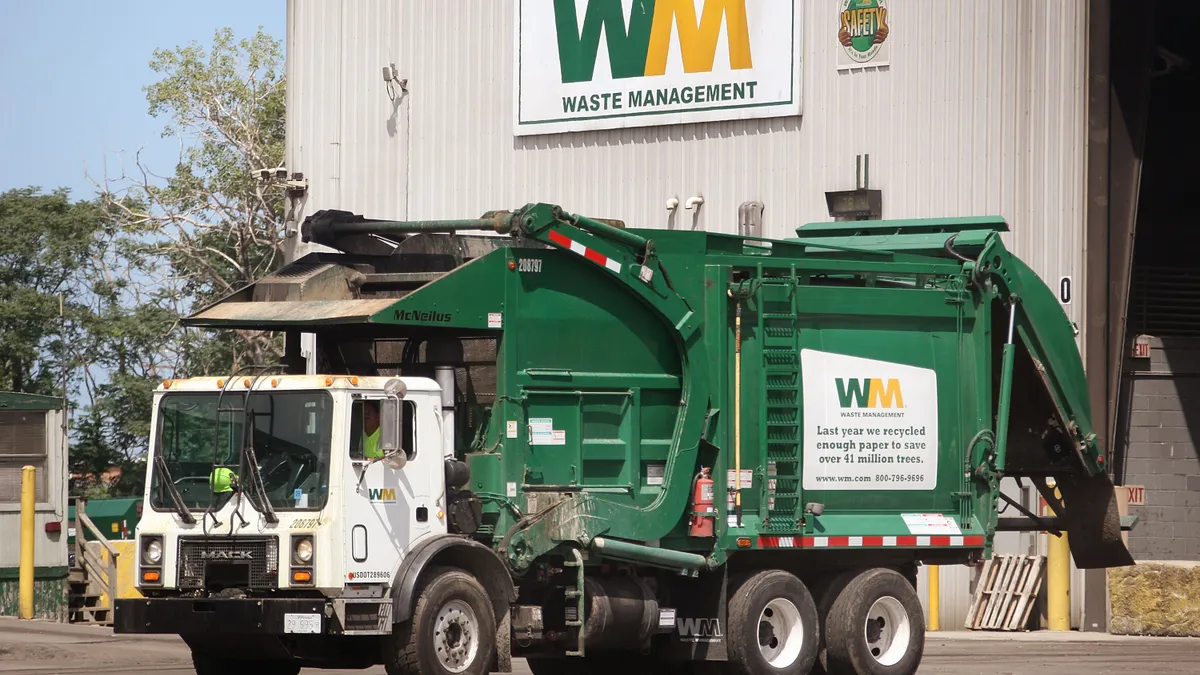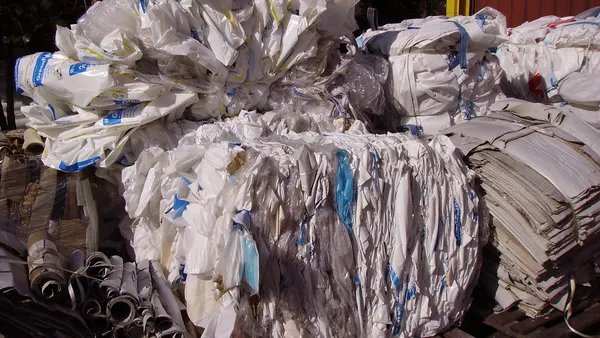Energy is among the many byproducts created during the waste management process, but in height of the country’s current clean power push, the industry’s role has yet to reach its full potential.
The waste industry has been creating various forms of energy from waste for decades, however output levels are still smaller than renewable sources such as wind or solar. While growth in the thermal conversion sector may be limited in the coming years, interest in new projects to create energy from landfill gas or anaerobic digestion is high. Spurred by federal incentives for transportation fuel and new state policy regulations, organic material may hold the key to making waste a bigger part of the country’s clean energy transformation.
"Food waste is the fastest growing component of the municipal waste stream and if you look at what is the technology that's best-suited to manage food waste, you come to either anaerobic digestion or composting," said Stephen Simmons, a senior vice president at the consulting firm Gershman, Brickner & Bratton. "That material isn't well-suited for a big combustion plant or a gasification plant."
Deciding which technology is right for each portion of the waste stream revolves around many economic and geographic factors, with the potential energy value shifting as well. As highlighted by a new report from the Business Council for Sustainable Energy and Bloomberg New Energy Finance, the U.S. energy market is competitive and average prices are low. This makes projecting the growth potential for different sectors a complicated process.
Waste-to-energy
As defined by the report, and many in the solid waste industry, "waste-to-energy" (WTE) traditionally refers to thermal conversion facilities — mostly mass burn combustion — that process various forms of mixed refuse. After energy crises during the ‘70s and ‘80s led to greater interest in building these types of projects the number of operational facilities has decreased since the mid-’90s.
According to the Energy Recovery Council, the U.S. currently has 77 operational facilities with an estimated 2,547 MW of capacity. That number has declined recently due to the closure of some smaller facilities, but the opening of larger ones in cities such as West Palm Beach, FL and Honolulu have helped keep overall capacity steady. WTE continues to play a key role in multiple states, though not at the level of what is happening in China or some European countries.
Public perception influenced by memories of polluting incinerators in the past remains one of the largest challenges for growth. Companies are still working to communicate the details of modern emissions control technology and multiple “zero waste” cities don’t see WTE playing a role in their long-term strategies. Low landfill tip fees can also make it tough to justify the capital investment in some parts of the country.
Public perception influenced by memories of polluting incinerators in the past remains one of the largest challenges for growth.

Waste Dive
Ted Michaels, president of the Energy Recovery Council, agrees that landfills are a driving factor — though he also sees them as an opportunity.
"There’s so much waste being landfilled in the country that there is just a lot of potential for waste-to-energy,” he said. "You’re going to want to be able to compete on the waste side, so maybe you’re in an area where landfilling is not cheap.”
Increasing revenue from steam and recovered metals, as well as special waste that may require assured destruction, is part of the business plan for the sector’s main players such as Covanta.
Simmons from GBB says additional revenue from byproducts is a way to make percentages more favorable for facilities. Whereas in the ‘80s and ‘90s he said the average mass burn facility derived 50% of its revenue from tip fees and 50% from power sales, that has now shifted to an average of 75% from tip fees as power prices decrease.
That may help existing combustion facilities, but newer conversion technologies are seen as having the most promising potential for near-term growth. Both Michaels and Simmons are particularly interested by the Enerkem facility in Canada and the Fiberight project in Maine.
"They both seem to be making solid progress," said Michaels. "There are certainly opportunities for other combustion technologies."
Landfills and anaerobic digesters
Methane’s role in climate change was a major focus of the Obama administration’s Environmental Protection Agency (EPA) and will continue to be regulated by new performance standards put in place. The growing recognition of methane's effects has led to more interest among municipalities and companies in diverting organics from landfills. Yet even if landfills didn’t receive a single scrap of food starting tomorrow, there would still be gas to capture from existing material for decades to come.
According to the recent Bloomberg report, the overall amount of capital expenditures for new landfill gas projects has been low in recent years. Though because this report didn’t take into account data from the EPA’s Landfill Methane Outreach Program (LMOP), that may not be the full picture.
Based on the latest LMOP data, 652 landfills are already capturing biogas to create some form of energy, 35 more have planned facilities and nine are under construction. On top of that, an additional 416 sites are considered candidates for biogas capture. When it comes to potential growth, the interest among companies and municipalities in new biogas capture gas systems that can create energy is already high.
The factors around anaerobic digestion can be more complicated. According to the American Biogas Council, 39 standalone digesters are currently processing food scraps in the U.S. with more than 1,500 other digesters at water resource recovery facilities or farms that could potentially co-digest food scraps.
"Historically, digesters have been only manure or only wastewater and now almost every digester mixes a bunch of feedstocks because every digester is a reflection of organic waste material that’s available locally," said Patrick Serfass, executive director of the American Biogas Council.
Co-digestion is already happening at facilities around the country and is seen as the key to enabling food scrap diversion programs in multiple cities. As for standalone facilities, estimates vary but at least 20 projects are currently in the pipeline, including major operations in California and New York. Though as is the case with other technologies, this growth is still behind what has been happening in other countries.
"We’re at an early stage of commercialization in terms of actually applying it in the U.S.," said Serfass.
Renewable natural gas and RIN credits
Among the many options for creating energy from food waste, upgrading biogas into renewable natural gas (RNG) to fuel vehicles is seen as one of the most promising avenues.
Converting fleets to run on compressed natural gas (CNG) or liquefied natural gas (LNG) has been a big priority for major companies and municipalities. Emissions reduction and operational efficiencies are part of the impetus, but the lucrative renewable identification number (RIN) credit system makes it even more appealing.
Since biogas was classified as a cellulosic biofuel in 2014 by the EPA it has qualified for RIN credits under the Renewable Fuel Standard (RFS) and experienced rapid growth. The amount of credits has risen every year for this category — the vast majority of which comes from waste-related sources — and is already off to a strong start in 2017. Landfills or anaerobic digestion facilities that upgrade their gas to RNG can now make much more money from RIN credits than from the gas alone.
"That was a game changer for the industry," said Johannes Escudero, CEO and executive director of the Coalition for Renewable Natural Gas. “We’ve tripled, in some cases quadrupled the value of our industry’s commodity."
According to LMOP data, 42 landfills currently have projects to upgrade their biogas that are either operational or in the works. Depending on the amount of waste, local demand for transportation fuel and pipeline connection options the hundreds of landfills with existing biogas capture facilities could be candidates for upgrading to RNG as well. The same goes for existing digestion facilities.
Capturing all of this potential growth can be difficult due to a lack of universal data sources and Escudero is much more bullish on the potential for RNG growth than the Bloomberg report indicates. He cites 53 existing RNG projects in the U.S. and aims to double that number by 2025. This includes the existing landfill projects listed by LMOP as well as five water resource recovery facilities and six anaerobic digestion facilities. Each of these projects requires an average $16 million investment and has job creation potential.
Based on his figures, Escudero says 28 new projects are in various stages of development and are expected to be operational by the end of the year. Another 12 projects are expected to come in 2018. This list includes at least two water resource recovery facilities, eight anaerobic digestion facilities and 13 landfills. Despite all of this potential, the cost for pipeline connection in some parts of the country — especially California — can make it hard to build smaller anaerobic digestion facilities.
"There’s political will, the technical ability exists, but the financial engineering is where they break down," said Escudero. "The cost of technology has to come down. Our industry has to figure out a way to reduce the cost."
Prior statements from the EPA also show uneven confidence that the fleet capacity to use these fuels can develop quickly enough. What the Trump administration, and new EPA administrator Scott Pruitt, could mean for this program is still unknown. They have expressed support for the RFS — originally created under the Bush administration — though even the smallest changes could affect growth.
"The cost of technology has to come down. Our industry has to figure out a way to reduce the cost."

Johannes Escudero
CEO, Coalition for Renewable Natural Gas
Escudero said that 10 years after its creation the RFS program continues to drive investments. He sees RNG growing at a similar or faster rate than solar in some states, without the subsidies that solar projects can access. Yet Escudero believes the program hasn’t reached its full potential and said his organization plans to fight any changes that would alter its effectiveness or be detrimental to this progress.
Serfass said the American Biogas Council will be watching to see how Pruitt proceeds on a rule involving “eRINs,” which would extend the credit to sources — such as landfills — creating energy from biogas for electric vehicles. He will also be watching to see that the RFS continues to operate on schedule and listening for comments from the new administrator. A letter of support from President Trump to the attendees of a recent ethanol conference is seen as a positive sign.
“Any kind of reassurance to the marketplace I think would go a long way,” said Serfass.
***
With all of these new technologies and policy drivers in play, it’s fair to say that the waste industry’s role in clean energy could look very different in the coming years. Organics diversion requirements will lead to further infrastructure development, which in turn may be bolstered economically by RIN credits and vehicle fuel opportunities.
Even with this economic support, municipalities may find that the cost of dealing with those final tons will become more expensive as they get closer to their high diversion targets in coming decades. Though perhaps by then the attitude toward combustion will have shifted or there will be a brand new WTE technology that could change the market entirely.


















